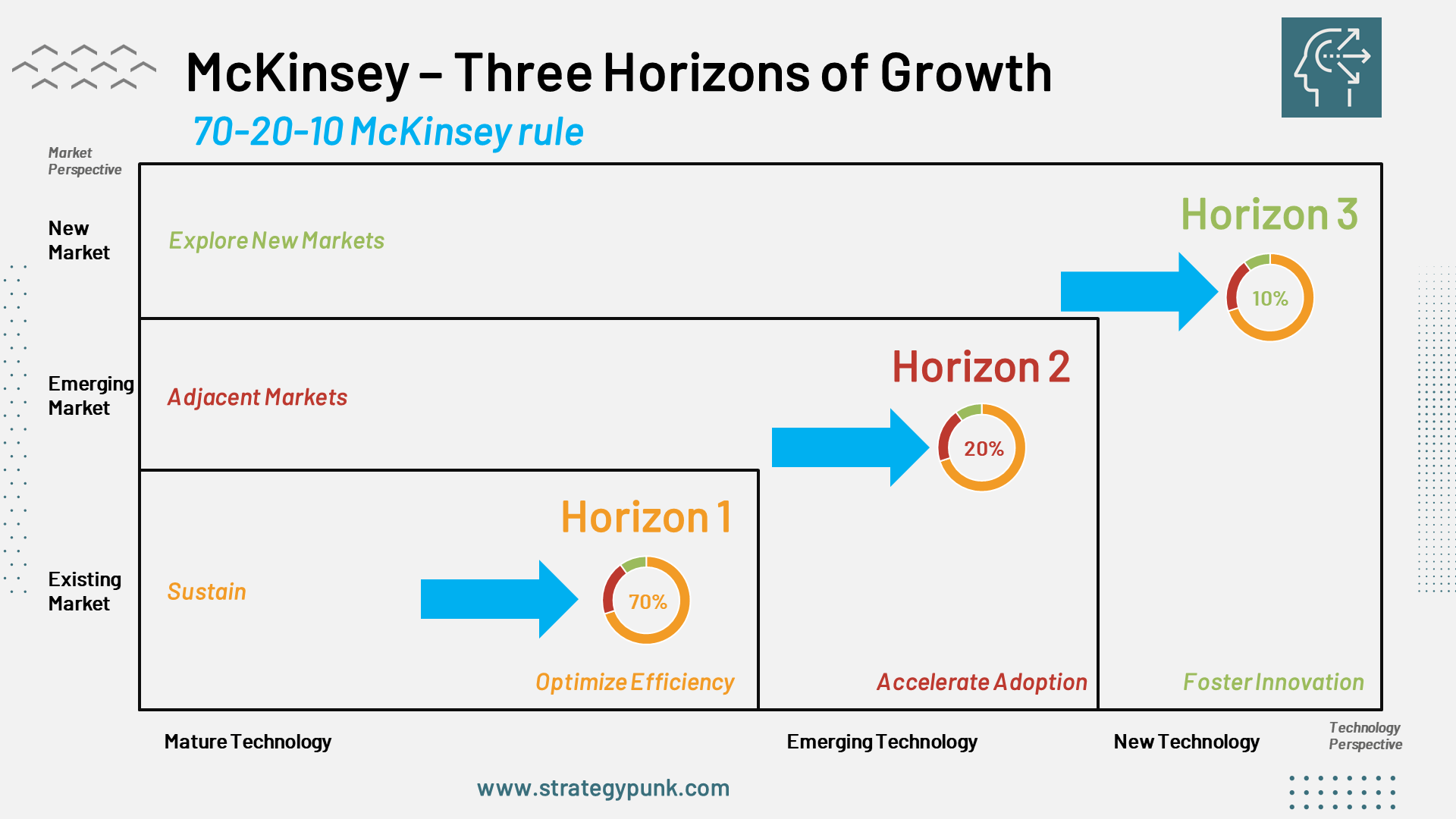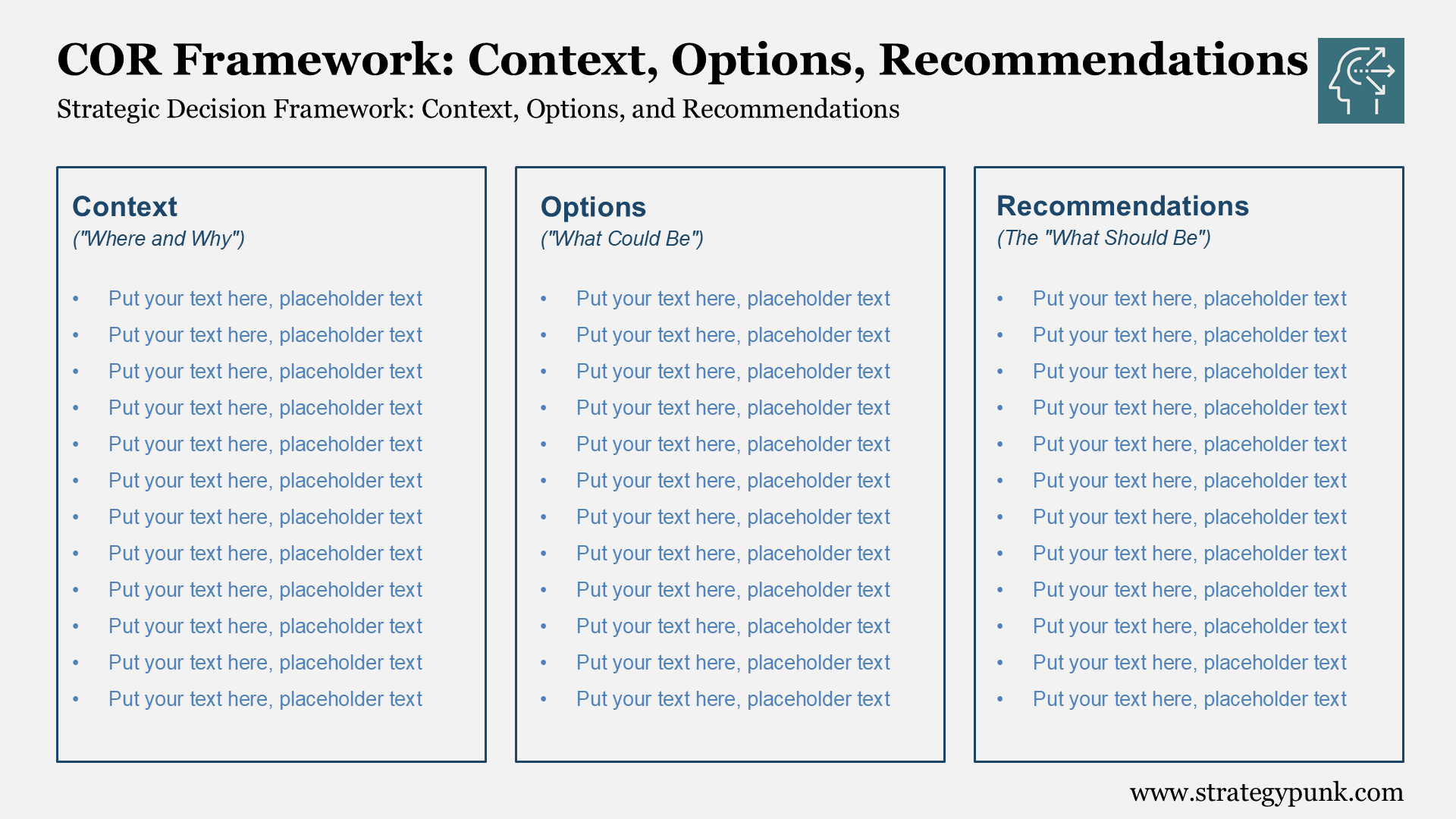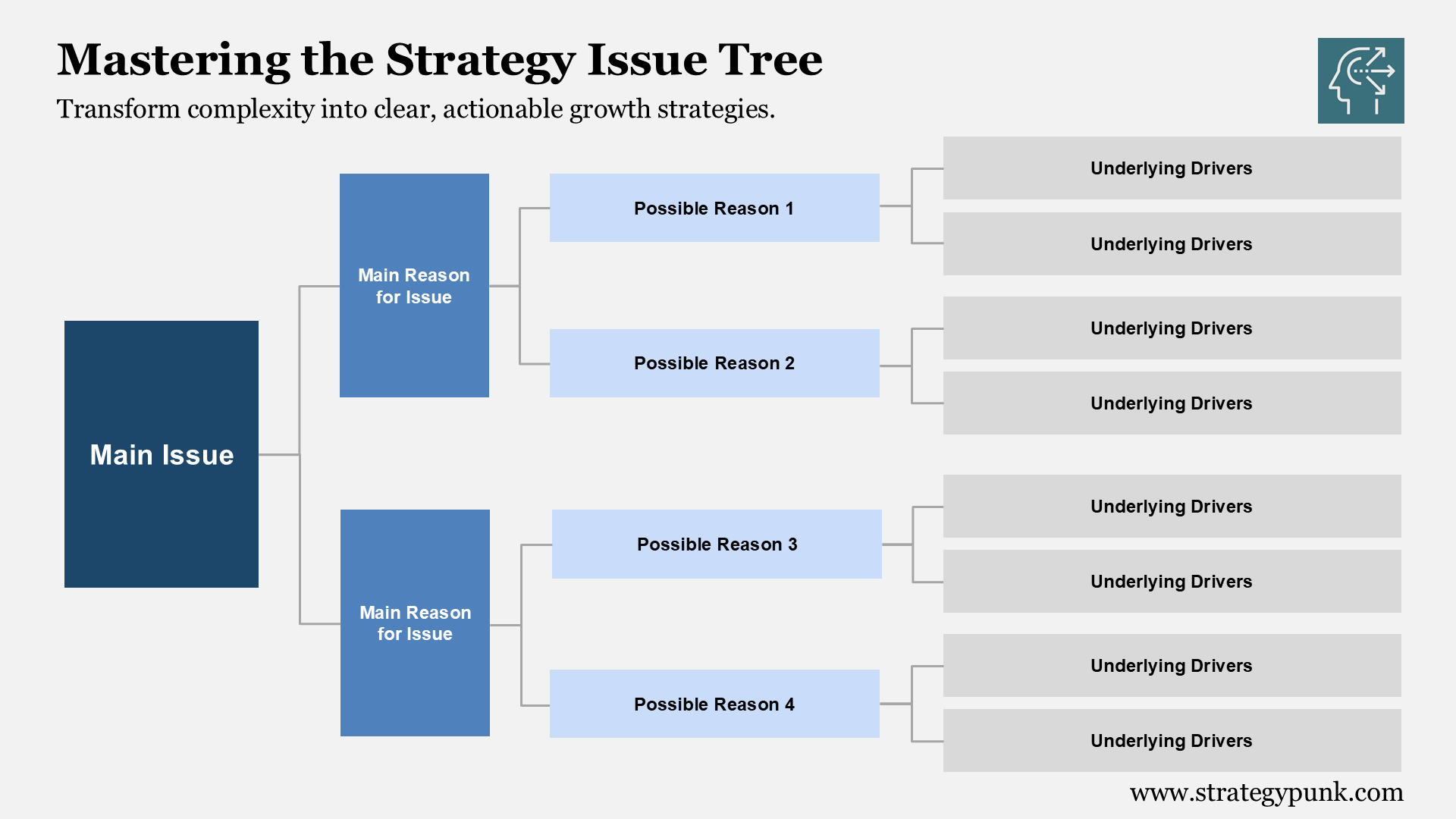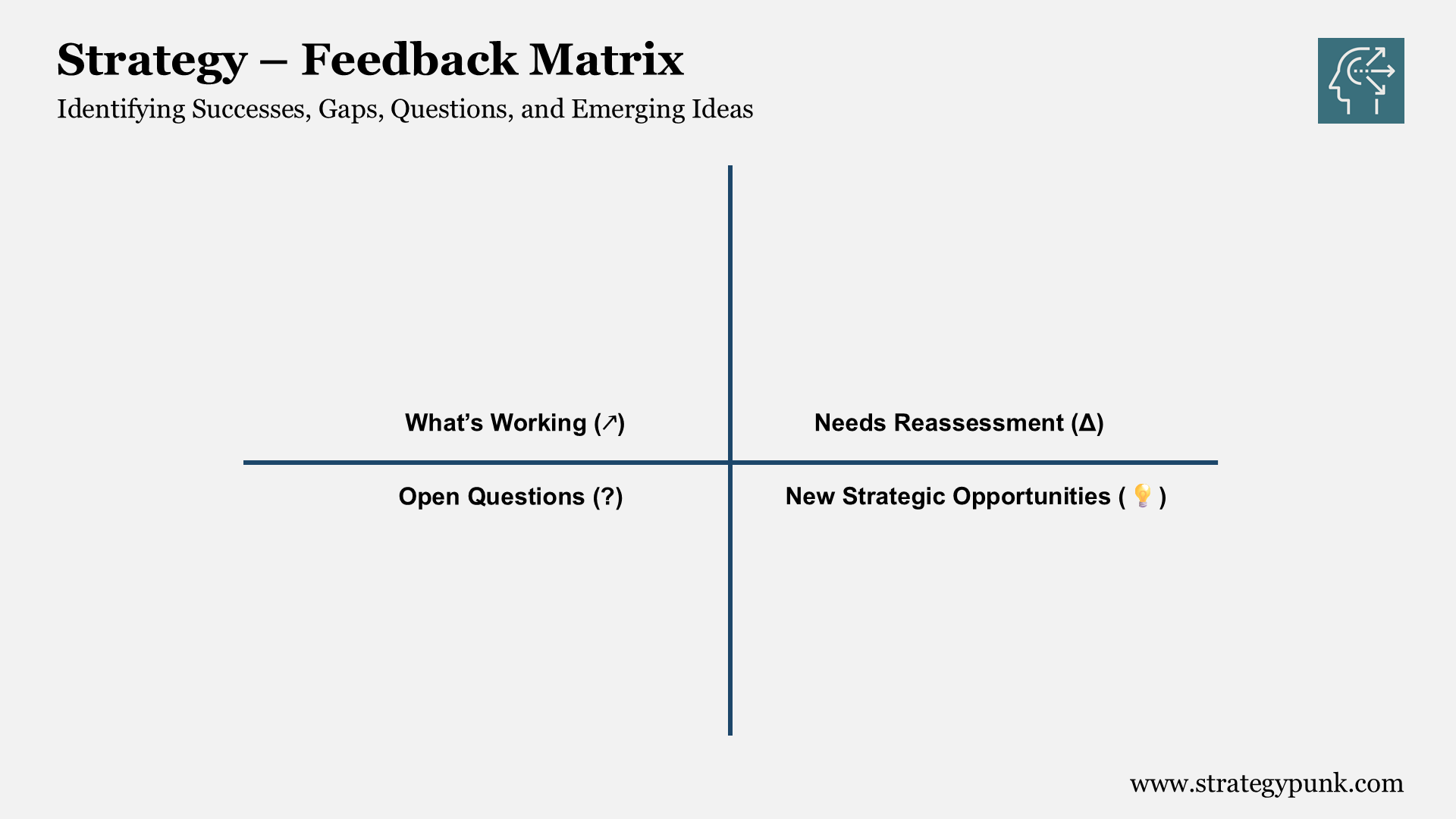McKinsey Three Horizons of Growth: A Strategic Framework for Business Expansion
Master business expansion with our McKinsey Three Horizons guide and free PowerPoint template for effective growth planning.

Discover the secrets to driving business growth with our comprehensive blog post exploring the McKinsey Three Horizons Framework.
Take advantage of the free, easy-to-use PowerPoint template available at the end of the post, perfect for strategizing your company's unstoppable expansion.
Introduction
In today's fast-paced business environment, organizations need a systematic approach to identifying and exploiting growth opportunities. McKinsey's Three Horizons of Growth model offers a strategic framework to help companies see beyond their immediate challenges and invest in long-term, sustainable growth.
The model categorizes growth opportunities into three horizons with distinctive characteristics and objectives. Horizon 1 optimizes core business activities to generate cash and maintain market position. Horizon 2 encourages organizations to explore new market segments and innovative offerings while preparing to scale them. Finally, Horizon 3 is about scouting and nurturing future growth opportunities that could fundamentally alter the company's competitive landscape.
Successfully implementing this framework can help organizations balance short-term performance and long-term value creation, enabling them to navigate the complexities of growth and maintain a competitive edge in their industry.
What are the Three Horizons of Growth?
The Three Horizons of Growth is a strategic framework developed by McKinsey & Company to help businesses map out their long-term growth strategy. This model focuses on planning for sustainable growth by dividing business initiatives into three interconnected horizons. Each horizon represents a different growth stage and has unique characteristics, objectives, and challenges. They are:
Horizon 1: Core Business
Horizon 1 is the core of the business, representing current products, services, and markets. This stage's primary focus is optimizing performance, maintaining market share, and generating revenue. Typical activities include refining operations, enhancing customer relationships, and maximizing profitability. It is a stable and relatively predictable environment but requires constant attention to avoid stagnation and decline.
Horizon 2: Emerging Opportunities
Horizon 2 centers on emerging opportunities, typically new products, services, markets, or business models that have the potential to generate new revenue streams in the mid-term. This horizon involves foresight, experimentation, and risk-taking. To succeed, businesses should cultivate a culture of innovation and flexibility while ensuring they have the necessary resources and commitment to develop these opportunities.
Horizon 3: Future Growth Engines
Finally, Horizon 3 encompasses future growth engines. These disruptive ideas or technologies can potentially revolutionize the industry or create new markets. This stage is the most uncertain and demands a long-term, visionary approach. To thrive in Horizon 3, organizations should foster a culture of curiosity and exploration, engage in strategic partnerships, and maintain a systematic approach to scanning and monitoring potential game-changers in their industry.
By understanding and effectively managing the three horizons, companies can balance their efforts across the different stages of growth and ensure long-term success.
Horizon 1: Existing Market and Mature Technology
Horizon 1 focuses on established markets and mature technologies. In this stage, companies prioritize optimizing efficiency in their current business operations. This allows them to maintain a competitive advantage and generate steady investment returns.
One aspect of Horizon 1 is continuously improving existing products and services. This involves:
- Refining product features and capabilities
- Enhancing operational processes
- Strengthening customer relationships
Another aspect is identifying opportunities for cost reduction and optimization. Companies can achieve this by:
- Streamlining supply chains
- Reducing production waste
- Automating repetitive tasks
By focusing on these elements, organizations can effectively maintain their market position and ensure a strong foundation for future growth opportunities within the existing market and technological landscape.
Horizon 2: Emerging Market and Emerging Technology
In the McKinsey Three Horizons of Growth framework, Horizon 2 bridges the current core business and the new growth areas. This stage is characterized by the emergence of disruptive innovations and the acceleration of their adoption in the market.
Emerging markets are regions or industries with high growth potential. They can be newly industrializing countries or innovative sectors where change occurs rapidly. These opportunities often come with risks as competition increases, and organizations must adapt to fluctuating market demands.
Emerging technologies, on the other hand, refer to advances and innovations that disrupt existing industries and create entirely new business models. Examples of such technologies include artificial intelligence, augmented reality, and blockchain.
At Horizon 2, organizations should focus on:
- Identifying potential markets and technologies that match their long-term strategic goals.
- Conducting research and development efforts to explore and create viable products or services based on emerging innovations.
- Investing in partnerships and acquisitions to leverage external expertise and access new capabilities.
During this stage, organizations must flexibly adapt their strategies and tactics, as they may face setbacks or unforeseen challenges in their pursuit of growth. They should be prepared to modify their plans according to market demands and allocate resources accordingly.
Horizon 2 represents a critical transitional phase in the Three Horizons of Growth, wherein companies explore new market and technological opportunities. This stage demands agility, experimentation, and a willingness to navigate uncertainties in pursuit of sustainable growth.
Horizon 3: New Market and New Technology
Horizon 3 represents the most uncertain and long-term layer of the Three Horizons of Growth framework. This horizon primarily focuses on new markets and emerging technologies that have the potential to revolutionize industries or create entirely new ones.
As industries progress through constant change and technological advancements, organizations must explore and embrace nascent possibilities to sustain their competitive edge. In Horizon 3, companies actively seek opportunities for growth beyond their core business, envisioning and investing in innovative ideas that are farther ahead in the development pipeline.
Some of the critical aspects of Horizon 3 include:
- Fostering a culture of innovation and experimentation
- Collaborating with research institutions and start-ups
- Allocating resources to uncharted areas and riskier projects
- Developing strategic partnerships with external players
One of Horizon 3's main challenges is the uncertainty associated with predicting the outcomes of these new ventures. Companies need to prepare for setbacks and be flexible in their approach, as every development at this stage involves a certain level of risk.
To navigate Horizon 3 effectively, organizations should prioritize learning, adaptability, and collaboration. Encouraging the flow of information between different departments or even collaborating with external partners can facilitate the discovery and development of new, disruptive technologies.
How do you use the Three Horizons of Growth?
The Three Horizons of Growth framework can be applied effectively to foster business growth and innovation. The process involves streamlining the allocation of resources (like time, money, and talent) across the three interconnected horizons of growth. By applying this framework, it becomes possible for organizations to identify and address the most critical opportunities at every stage. Below are some steps to effectively utilize the Three Horizons of Growth:
Step 1: Define your horizons
You can begin by clearly defining the three horizons for your organization. Each horizon should correspond to a different aspect of growth or innovation:
- Horizon 1: Core business activities and strategies to sustain and grow the current organization.
- Horizon 2: Emerging ideas and projects that have the potential to generate future growth and revenue streams.
- Horizon 3: Long-term opportunities that may disrupt and transform the business landscape.
Step 2: Assess the current state of your organization
Analyze your organization's strategy, strengths, and weaknesses across the three horizons. Evaluate resources, initiatives, and potential risks within each. This step helps identify areas where adjustments might be required to allocate resources and effort better to achieve balanced growth.
Step 3: Prioritize
Once the organization's current state has been assessed, prioritize critical initiatives within each horizon. Consider each initiative's potential impact, resource requirements, and how much it aligns with the organization's strategic goals.
Step 4: Allocate resources
With priorities established, allocate resources (financial, human, and time) to the most important initiatives on each horizon. Ensuring a proper balance of resources is crucial to the organization's long-term success, as it helps maintain focus on both short-term growth and long-term innovation.
Step 5: Monitor and adjust
Monitor progress across the three horizons regularly, adjusting the allocation of resources and priorities as needed. This will ensure that the organization remains agile and adaptable to changes in its industry and the larger business environment.
What is the 70-20-10 McKinsey Rule?
The 70-20-10 McKinsey rule is a widely known framework within innovation management. This helpful guideline for businesses aims to prioritize and allocate resources effectively for innovation projects. A company can simultaneously focus on core, adjacent, and breakthrough innovation by adhering to the rule, ensuring long-term success and resilience.

The 70-20-10 rule is broken down into three parts, distributing efforts across three innovation horizons as follows:
- 70% - Core: This covers the company's primary focus, dedicating 70% of resources to safeguard and grow its current operations, products, and services. This concentration on the core business helps maintain a solid foundation to build future innovations.
- 20% - Adjacent: About 20% of the company's innovation efforts should be directed toward expanding existing products, services, or solutions into new markets. Adjacent growth allows for manageable risks and potential for increased revenue.
- 10% - Breakthrough: The remaining 10% of resources should be allocated to ambitious and transformative projects that may disrupt the industry or create game-changing innovations. Breakthrough innovations, though typically high-risk, could provide a significant competitive advantage if successful.
Companies that adopt the 70-20-10 McKinsey rule can achieve a balance between maintaining existing operations and exploring new opportunities. Such a strategic approach encourages growth and minimizes the risk of stagnation, all while optimizing the allocation of resources for an innovative and forward-looking organization.
Conclusion
In summary, McKinsey's Three Horizons of Growth framework offers a structured approach for companies to balance their focus and resources on long-term sustainable growth. The model emphasizes the importance of simultaneously investing in the core business (Horizon 1), emerging growth areas (Horizon 2), and creating new opportunities for the future (Horizon 3).
By adopting this strategic framework, organizations can:
- Maintain a healthy mix of short-term and long-term priorities
- Maximize the growth potential in existing markets and businesses
- Explore new opportunities and areas for future growth
Successful implementation of the Three Horizons of Growth requires effective communication, precise alignment of resources and timings, and strong governance to achieve a balanced portfolio of growth projects. Leaders must drive the process with vision and commitment, ensuring that the organization remains agile and responsive to changes in the business landscape.
Ultimately, the Three Horizons of Growth model is a valuable strategic planning tool for companies seeking to create a sustainable growth trajectory, foster innovation, and ensure long-term success.
McKinsey Three Horizons of Growth PowerPoint Template
Free and fully editable PowerPoint Template
Ready to skyrocket your business growth?
🎯 Dive into this strategic framework and visualize your expansion like never before using our exclusive box-style template.
🎁 Don't wait; download the template now and start your journey towards unstoppable success!

🚀 Unlock exclusive access to the FREE PDF and PowerPoint template by logging in or signing up now!





